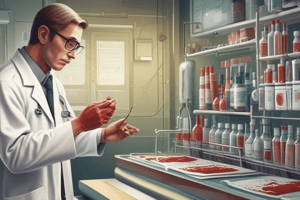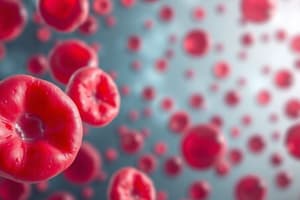Podcast
Questions and Answers
What is the inheritance pattern of Ehlers-Danlos syndrome?
What is the inheritance pattern of Ehlers-Danlos syndrome?
- Autosomal recessive
- Autosomal dominant (correct)
- X-linked dominant
- Mitochondrial
Which physical findings are associated with Marfan syndrome?
Which physical findings are associated with Marfan syndrome?
- Long limbs and dislocated lenses (correct)
- Hyperelastic skin and joint hypermobility
- Easy bruisability and excessive postpartum bleeding
- Short stature and skin fragility
What is a major cause of death in individuals with Pseudoxanthoma elasticum?
What is a major cause of death in individuals with Pseudoxanthoma elasticum?
- Lung disease
- Joint dislocations
- Subarachnoid and GI bleeding (correct)
- Cardiovascular complications
What enzyme deficiency is associated with Ehlers-Danlos syndrome?
What enzyme deficiency is associated with Ehlers-Danlos syndrome?
What is one of the laboratory findings associated with Ehlers-Danlos and Marfan syndrome?
What is one of the laboratory findings associated with Ehlers-Danlos and Marfan syndrome?
Which vitamin is essential for maintaining the structural integrity of blood vessels and is deficient in Scurvy?
Which vitamin is essential for maintaining the structural integrity of blood vessels and is deficient in Scurvy?
What type of connective tissue defect is observed in Marfan syndrome?
What type of connective tissue defect is observed in Marfan syndrome?
Which of the following statements best describes Scurvy?
Which of the following statements best describes Scurvy?
What is one of the effects of diabetes mellitus on blood vessels?
What is one of the effects of diabetes mellitus on blood vessels?
What triggers endothelial damage in the context of vasculitis?
What triggers endothelial damage in the context of vasculitis?
Which condition is characterized by purpura secondary to allergic reactions?
Which condition is characterized by purpura secondary to allergic reactions?
What is the cause of mechanical purpura?
What is the cause of mechanical purpura?
Which type of purpura can result from the use of anticoagulant drugs?
Which type of purpura can result from the use of anticoagulant drugs?
What can lead to the formation of purpura at the skin surface due to amyloidosis?
What can lead to the formation of purpura at the skin surface due to amyloidosis?
What is a common symptom of Henoch-Schönlein Purpura?
What is a common symptom of Henoch-Schönlein Purpura?
Which of the following is NOT a cause of purpura?
Which of the following is NOT a cause of purpura?
What term is used to describe purplish red, pinpoint hemorrhagic spots on the skin that are less than 3 mm in diameter?
What term is used to describe purplish red, pinpoint hemorrhagic spots on the skin that are less than 3 mm in diameter?
Which type of bleeding disorder is characterized by clinical findings of purpura with a normal platelet count?
Which type of bleeding disorder is characterized by clinical findings of purpura with a normal platelet count?
Which of the following describes the condition known as menorrhagia?
Which of the following describes the condition known as menorrhagia?
What is the primary characteristic of hematuria?
What is the primary characteristic of hematuria?
Which term refers to the vomiting of blood?
Which term refers to the vomiting of blood?
Ecchymosis is defined as:
Ecchymosis is defined as:
What is the typical appearance of melena?
What is the typical appearance of melena?
Which of the following statements is true about bleeding time screening tests?
Which of the following statements is true about bleeding time screening tests?
What is a common physical finding associated with bleeding disorders caused by vascular defects?
What is a common physical finding associated with bleeding disorders caused by vascular defects?
What lab finding is typically indicative of a deficiency in Vitamin C?
What lab finding is typically indicative of a deficiency in Vitamin C?
Which condition is characterized by red to purple ecchymotic areas that may lead to browning due to hemoglobin retention?
Which condition is characterized by red to purple ecchymotic areas that may lead to browning due to hemoglobin retention?
What is a consequence of excessive glucocorticoids in Cushing Syndrome?
What is a consequence of excessive glucocorticoids in Cushing Syndrome?
What is a hallmark of Hereditary Hemorrhagic Telangiectasia?
What is a hallmark of Hereditary Hemorrhagic Telangiectasia?
Which of the following conditions is associated with congenital hemangiomata?
Which of the following conditions is associated with congenital hemangiomata?
Which symptom indicates the presence of small blood vessel fragility due to corticosteroid therapy?
Which symptom indicates the presence of small blood vessel fragility due to corticosteroid therapy?
What is a primary characteristic of petechiae related to bleeding disorders?
What is a primary characteristic of petechiae related to bleeding disorders?
What is the platelet count threshold below which severe and spontaneous bleeding is highly possible?
What is the platelet count threshold below which severe and spontaneous bleeding is highly possible?
Which syndrome is characterized by inherited thrombocytopenia with small platelets and decreased platelet aggregation?
Which syndrome is characterized by inherited thrombocytopenia with small platelets and decreased platelet aggregation?
Which of the following conditions is associated with inherited thrombocytopenia with large or giant platelets?
Which of the following conditions is associated with inherited thrombocytopenia with large or giant platelets?
Which syndrome is linked to congenital thrombocytopenia with normal-sized platelets?
Which syndrome is linked to congenital thrombocytopenia with normal-sized platelets?
Which inherited disorder is associated with macro-thrombocytopenia and the absence of platelet granules?
Which inherited disorder is associated with macro-thrombocytopenia and the absence of platelet granules?
What genetic mutation is linked to amegakaryocytic thrombocytopenia?
What genetic mutation is linked to amegakaryocytic thrombocytopenia?
Which condition is associated with the development of acute myeloid leukemia (AML)?
Which condition is associated with the development of acute myeloid leukemia (AML)?
Which of the following disorders is a rare autosomal recessive condition associated with large or giant platelets?
Which of the following disorders is a rare autosomal recessive condition associated with large or giant platelets?
Flashcards are hidden until you start studying
Study Notes
Bleeding Disorders caused by Vascular Defects
- Characterized by non-thrombocytopenia purpura.
- Platelet count and screening tests for coagulation factors are usually normal.
I. Connective Tissue Defects
A. Inherited
- Ehlers-Danlos syndrome:
- Autosomal dominant.
- Physical findings: hyper extensible joints & hyperplastic skin.
- Connective tissue of the skin, vasculature, and bones is adversely affected, causing a lack of structural support in these tissues and great tissue fragility.
- Large skin ecchymosis & hematomas, bleeding from gums, excessive postpartum bleeding, GI bleeding, easy bruisability.
- Defect: peptidase enzyme deficiency (converts procollagen to collagen).
- Lab findings: Increased/prolonged bleeding time.
- Pseudoxanthoma elasticum:
- Rare; autosomal recessive.
- Connective tissue elastic fibers in small arteries are calcified and structurally abnormal.
- Subarachnoid and GI bleeding are the most common cause of death.
- Lab findings: Not significant.
- Marfan syndrome:
- Autosomal dominant; carried by fibrillin-1 (FBN-1) gene.
- Blood vessels have decreased strength and elasticity.
- Marked by long limbs, dislocated lenses & aortic root dilation.
- May also affect the lungs, dural sac around the spinal cord and the hard palate.
- Lab findings: Increased/prolonged bleeding time.
B. Acquired
- Scurvy:
- Vitamin C is a cofactor for the enzymes required for the conversion of procollagen to collagen, which is necessary to maintain the structural integrity of blood vessels.
- Physical findings: gingival bleeding and hemorrhage into subcutaneous tissues and muscles, petechiae on thighs and buttocks, particularly around the hair follicles. Large hemorrhagic areas may develop below the eyes.
- Lab findings: Anemia; decreased Vitamin C level in plasma (Ref range: 0.5 -1.0 mg/dL); positive tourniquet test.
- Senile Purpura:
- Acquired and chronic disorder of the elderly due to the degeneration of collagen, elastin and subcutaneous fat due to the aging process.
- Red to purple ecchymotic areas on the forearm and on the back of the hands, and neck which retains a permanent brownish color, possible due to hemoglobin that is not properly removed by the aging macrophage system.
- Cushing Syndrome and Corticosteroid Therapy:
- Excess glucocorticosteroids result in excessive breakdown of collagen, thin, fragile skin, vessel wall fragility, and bruising.
- Small blood vessels can be mechanically broken and bleed into the skin.
II. Altered Vessel Wall Structure
A. Inherited
- Hereditary Hemorrhagic Telangiectasia:
- Characterized by the presence of skin lesions due to thin, dilated vessels that may bleed spontaneously or from minor trauma.
- They appear most commonly on the face, lips, tongue, mucous membranes of the mouth and the nose, the ears, conjunctivae, and the palms of the hands and soles of the feet.
- The telangiectasia is permanent.
- Due to bleeding tendencies, anemia may develop from iron deficiency.
- All tests for coagulation are normal.
- Congenital hemangiomata (Kasabach - Merritt Syndrome):
- A disorder associated with tumors composed of vessels that commonly swell and bleed at the surface.
- When platelet count is below 10 x 10^9/L, the possibility of severe and spontaneous bleeding is high.
III. Endothelial damage/Vasculitis
- Inflammation of the small blood vessels usually occurring when immune complexes attach to endothelial cells or the underlying subendothelial structures and activate complement.
- Autoimmune Vascular purpura:
- Drug-induced.
- Allergic purpura.
- Henoch- Schönlein Purpura:
- A type of allergic purpura characterized by abdominal pain due to GIT hemorrhage, joint pain esp of the knee, ankles, and wrists.
- Infectious purpura.
IV. Miscellaneous Causes of Purpura
- Mechanical Purpura:
- Increased pressure within the lumen of capillaries after intense exercise, coughing spasms, or epileptic seizures can cause petechial hemorrhages in the skin.
- Artificially induced purpura:
- Bruises resulting from accidents or abuse, overuse of anticoagulant drugs or placing negative pressure on the skin.
- Easy bruising syndrome (purpura simplex):
- A benign condition that commonly occurs in women.
Basic Terminology for Clinical Findings in Bleeding Disorders
- Petechiae:
- Purplish red, pinpoint hemorrhagic spots, less than 3 mm in diameter, in the skin caused by loss of capillary ability to withstand normal blood pressure and trauma. Characteristic of abnormalities of platelets and blood vessels and usually are not seen in coagulation factor disorders.
- Purpura:
- A general term referring to all bruises from petechiae to ecchymoses.
- These are red areas in the skin (>3mm but less than 1 cm) that eventually turn purple then brownish yellow, caused by hemorrhage of blood into small areas of skin, mucous membranes and other tissues.
- Ecchymosis:
- A form of purpura larger than 1 cm in diameter, in which blood escapes into large areas of skin or mucous membranes but not into deep tissue; commonly from a blood vessel larger than a capillary.
- They are red or purple when first formed and become yellowish green as they heal.
- Epistaxis:
- Nosebleed.
- Hemarthrosis:
- Leakage of blood into a joint cavity.
- Hematemesis:
- Vomiting of blood.
- Hematoma:
- A blue or purple, raised or swelling area in the organ or tissues caused by blood leaking from an opening in a vessel and collecting beneath intact skin.
- Hematuria:
- Intact red cells in the urine.
- Hemoglobinuria:
- Refers to hemoglobin in the urine.
- Hemoptysis:
- Expectoration of blood secondary to hemorrhage in the larynx, trachea, bronchi, or lungs.
- Melena:
- Stool containing dark red or black blood.
- Menorrhagia:
- Excessive menstrual bleeding.
Screening Tests for Defects of Primary Hemostasis
- Platelet Count: To assess platelet numbers.
- Bleeding Time: To assess platelet function.
- PT/APTT: To assess coagulation factors.
Thrombocytopenia
A. Decreased Production
1. Congenital
- Inherited Thrombocytopenia with small platelets:
- Wiskott-Aldrich syndrome (WAS):
- Also shows decreased platelet aggregation to ADP, epinephrine and collagen; and decreased Tcell number and function.
- X-linked thrombocytopenia.
- Autosomal dominant with microthrombocytes.
- Wiskott-Aldrich syndrome (WAS):
- Inherited Thrombocytopenia with normal size platelets:
- Fanconi’s anemia/syndrome.
- Thrombocytopenia with absent radii (TAR).
- Amegakaryocytic thrombocytopenia - mutation in MPL gene (encoding TPO receptor).
- Familial platelet disorder with a propensity to develop AML
- Quebec platelet disorder.
- Dysmegakaryopoietic thrombocytopenia.
- Inherited Thrombocytopenia with Large/Giant platelets:
- Bernard - Soulier syndrome:
- Rare inherited blood clotting disorder, large or giant platelets, thrombocytopenia and prolonged bleeding time.
- Mediterranean stomatocytosis/ Macrothrobocytopenia:
- Rare autosomal recessive disorder, enhanced GI absorption, reduced excretion of plant sterols (sitosterolaemia).
- Grey platelet syndrome:
- Macro-thrombocytopenia, absence of platelet -granules resulting in typical gray platelets. Associated with bleeding tendency, myelofibrosis and splenomegaly.
- White platelet syndrome.
- May-Hegglin anomaly.
- Digeorge’s syndrome.
- Fechtner syndrome.
- Epstein syndrome.
- Sebastian syndrome.
- Paris-Trousseau Thrombocytopenia (Jacobsen’s syndrome).
- Down’s syndrome.
- Homozygous Pelger-Huet anomaly.
- Giant platelets with mitral valve insufficiency.
- Giant platelets with ineffective erythropoiesis.
- Montreal platelet syndrome.
- Platelet type von Willebrand’s disease.
- Bernard - Soulier syndrome:
Studying That Suits You
Use AI to generate personalized quizzes and flashcards to suit your learning preferences.




